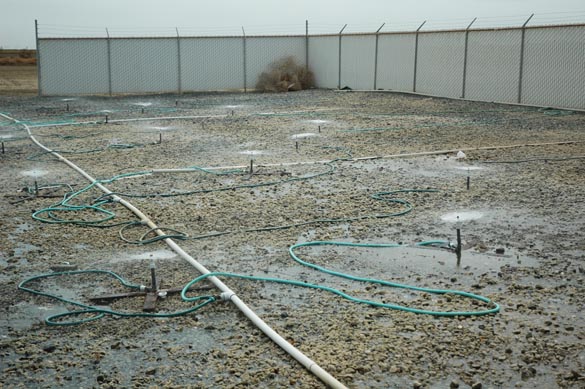|
THE SHUTTLEWORTH-WALLACE METHOD: ONLINE CALCULATION
Rosa D. Aguilar and
Victor M. Ponce
|
1. INTRODUCTION
An online calculator for the Shuttleworth-Wallace evapotranspiration formula is developed herein (Shuttleworth and Wallace 1985).
The formula is based on an energy combination theory in which evaporation is calculated based on the resistances associated with the
plants and with the soil or water in which they are growing. The equation is based on a one-dimensional model
in which the transition between the asymptotic limits of bare substrate and closed canopy is evaluated.
The equation is an improved
version of the Penman-Monteith equation for evaporation and evapotranspiration.
2. DALTON FORMULA
Early studies had shown that evaporation rate is a function of the
difference between the saturation vapor pressure at the water surface temperature es, and the
vapor pressure of the overlying air ea.
As evaporation continues to take place, the lowest layer of the atmosphere eventually becomes
saturated and the net evaporation rate tends to diminish and even reverse.
Therefore, an agent such as the wind, which carries away the water molecules as they leave the water surface,
is necessary for continuous evaporation. The recognition of these processes led Dalton
to formulate the classical law of evaporation bearing his name:
In which E = evaporation rate, f(u) = a function of the horizontal wind speed, es =
saturation vapor pressure at the water surface temperature, and ea = vapor pressure of the overlying layer.
3. PENMAN FORMULA
Penman used the energy budget method and the
mass-transfer approach of Dalton to develop a practical combination equation for the calculation of evaporation.
Penman's formula is (Ponce 1989):
E = f(u) (es - ea)
|
|
in which
E = evaporation rate (cm/day);
En = evaporation due to net radiation (cm/day);
Ea = evaporation due to mass transfer (cm/day);
Δ
= saturation vapor-pressure gradient between water and air temperatures, defined as follows:
in which Ts = water surface temperature and Ta = temperature of the overlying air. The quantity Δ can be estimated using the following formula:
| Δ = (0.00815 Ta + 0.8912) 7 |
where Ta is measured in °C, applicable for temperatures greater than - 25°C. The quantity γ is a psychrometric constant, approximately equal to 0.66 mb/°C.
4. PENMAN-MONTEITH FORMULA
The Penman-Monteith is a modification of the Penman formula that includes aerodynamic and stomatal resistances.
These resistances give deterministic meaning to the mass-transfer approach.
The Penman-Monteith formula can be expressed as follows:
in which
E = evaporation rate (cm/s);
Δ = saturation vapor-pressure gradient with temperature [mb (°C-1)];
H = energy flux supplied externally, by net radiation (cal cm-2 s-1);
ρa = density of moist air (gr cm-3);
cp = specific heat of moist air [cal gr-1 (°C-1)];
(es - ea) = vapor pressure deficit (mb);
ra = external (aerodynamic) resistance (s cm-1);
λ = heat of vaporization of water (cal gr-1);
ρ = density of water (gr cm-3);
γ* = modified psychrometric constant, in mb (°C-1), equal to
γ* = γ [1 + (rs/ra)]
in which
rs = internal (stomatal or surface) resistance (s cm-1).
ra = external aerodynamic resistance (s cm-1).
The Penman-Monteith equation can be expressed in Penman form using the following equation:
|
|
In which the mass transfer evaporation rate Ea can be calculated based on physical properties through the following equation:
|
Ea = K _________ ra + rs |
In which K is a constant expressed per unit of vapor pressure deficit (mb-1), varying with temperature and atmospheric pressure as follows:
|
K = 86400 _________ ρ λ γ |
5. SHUTTLEWORTH-WALLACE FORMULA
The Shuttleworth-Wallace formula is a combination equation based on the Penman-Monteith method for the calculation of evaporation. The calculation is based on physical properties of the resistances from the plants and the
soil or water in which they are growing. The equation is:
in which
λE = latent heat flux from the complete crop (W m-2);
Cc and Cs are coefficients, and PMc and PMs are evaporation
terms similar to the Penman-Monteith combination equation. The formulas are:
λE = Cc PMc + Cs PMs
|
in which
A = total energy flux leaving the complete crop as sensible latent heat per unit ground area (W m-2);
As = total energy flux leaving the substrate as sensible latent heat per unit ground area (W m-2);
cp = specific heat at constant pressure (J kg-1 °K-1);
C = extinction coefficient of the crop for net radiation (dimensionless);
ex = vapor pressure at reference height (mb);
ew (T) = saturated vapor pressure at temperature T (T = Tx, T0, Ts) (mb);
D = vapor pressure deficit at reference height: [ ew (Tx) - ex ] (mb);
L = projected area of leaf per unit ground area (leaf area index) (dimensionless);
rST = mean stomatal resistance (s m-1);
rb = Mean boundary layer resistance per unit area of vegetation (s m-1);
raa = aerodynamic resistance between canopy source height and reference level (s m-1);
rac = bulk boundary layer resistance of the vegetative elements in the canopy (s m-1);
ras = aerodynamic resistance between the substrate and the canopy source height (s m-1);
rsc = bulk stomatal resistance of the canopy (s m-1);
rss = surface resistance of the substrate (s m-1);
Rn = net radiation flux into the complete crop (W m-2);
Rns = net radiation flux into the substrate (W m-2);
γ = psychrometric constant [mb (°K)-1]; and
ρ = density of air (kg m-3).
The online calculator for the Shuttleworth-Wallace formula can be accessed by clicking on this link: Online Shuttleworth-Wallace Calculator.
REFERENCES
Ponce, M. V., 1989. Engineering Hydrology: Principles and practices Prentice Hall, Englewood Cliffs, New Jersey.
Shuttleworth, J. W. and J. S. Wallace, 1985. Evaporation of sparse crops-an energy combination theory. Quarterly Journal of the Royal Meteorological Society, Vol. III, pp. 839-885. January.
